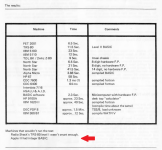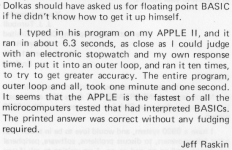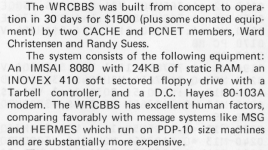It occurred to me, why wasn't any Wang model not also in the benchmark test? I mean, sure, they just tested a few systems that they had available (which did also include several non-microprocessor examples, like the Interdata 7/16, 5100, PDP). Just of all those very nice systems (including some HP systems), but they had no Wang model also?
EDIT: In a 1980 Computerworld article, the Wang 2200VP model got decent benchmark rankings against other office-computers (like the TRS-80 Model II or some higher-end HP and TI systems). I guess maybe the main point of the 1978 article was showing that you had some sub-$1k systems being very competitive against $10k+ systems (which is a valid point, but of course there is more to the cost/benefit-of-ownership than raw performance)
I ran this benchmark on the Wang 2200B emulator, to at least verify that it was capable of running this correctly -- which it did, taking about 15 seconds on my system (not sure how representative that is of real hardware -- the emulator probably throttles to a semi-realistic timing, but point is its BASIC interpreter was fully FP capable even in '73). But by '78, there was the 8080-based Wang 1200 WPS (or IOS). Lots of BASIC's out there before Bill's "open letter" (but sure, his maybe was the first one ported to the 8080, thanks to a certain emulator and various file editors) :D



